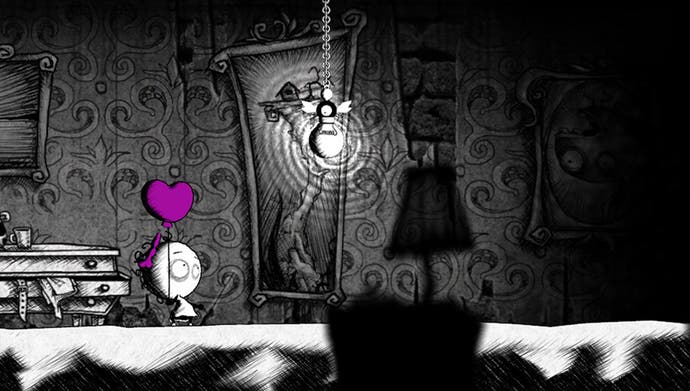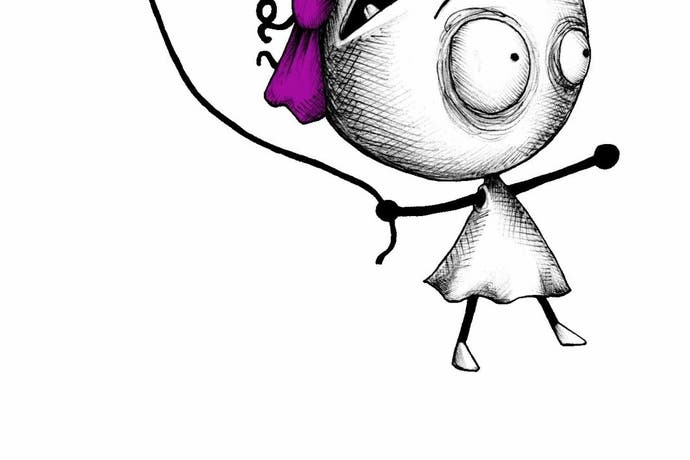The human touch: the brilliance of Murasaki Baby
The Vita's latest addition marks a change of direction for Shadow of the Damned's creator.
It is, many people will tell you, one of the finest pieces of design in videogames. Ico's power, its emotional impact, comes through a world of minimalist fantasy and a relationship delicately painted, but it all truly comes together in one feature: the gentle tug between Ico and Yorda, and the simple thud of the Dual Shock as you pull her along.
Massimo Guarini, the Italian developer who previously worked on Shadows of the Damned and helped bring Suda 51's strange vision to life, knows that well. The first game from his new studio, Ovosonico, is built around that simple moment of contact. In Murasaki Baby, you take a child by the hand and guide her through a nightmare world.
This is a Vita exclusive game, and Guarini and his nine-strong team are playing to the handheld's strengths and peculiarities. The front touch screen lets you reach out and grab the child's hand, and pulling it to the right pulls her through Murasaki Baby's darkly comic world.
The mechanic comes alive in the sullen resistance of the child - she's a reluctant passenger, often sulkily dragging her feet or pushing back. At first it's odd, like the controls aren't quite working correctly (and to an extent they're not - Murasaki Baby's only a handful of months into development and a way from its projected 2014 release) but then it clicks. In her unwillingness to co-operate, she's one of the most convincingly human characters that has fronted a game in some time.
It's a human element that Guarini's built his game around. "The concept behind Murasaki Baby is trying to deal with emotional game design, and it's about building a relationship with the main character," he says. "I think what's unique to the game and touch controls is that you actually physical grab the child's hand with the controller. Just by interacting in that way you start immediately having some emotional reaction."

Even within the short slice that's being shown Murasaki Baby manages to evoke that reaction. Within the opening level there are obstacles in the child's way - gaps that must be swiped to guide her across, or floating safety pins that bear down on her for you to tap away. The danger's slight but tangible - when there's darkness she'll cower in the corner, prompting you to find lamps and hook them up in a passageway to light the path ahead.
She clutches a balloon that will drift away when she's hurt by enemies, and you have to guide it back to her using the touchscreen to ensure she doesn't die. It's a system that's similar in style and execution to the wailing baby Mario in Yoshi's Island, and it's one of the first signs that Guarini shares several philosophies with Nintendo, even if his vision has a darker taint.
"From a creative point of view 99 per cent of my inspiration comes from outside of games," he says. "Miyamoto said the same thing - get a life, go outside and do things, talk with people and that's where you get your ideas from. The more you play games, the more you get caught in the same loop, you come up with the same ideas, the same vocabulary, the same dogmas that are actually chaining games and not making them expand to a wider audience. I don't care about hardcore or casual, but expanding the audience is inevitable. I don't want games to just be for teenagers and nerds."
To that end Murasaki Baby's going to be a short game, tailored not for time-rich teens but for adults with busy schedules. "I wanted to pack a strong emotional impact into a small package rather than a 40-hour game where you inevitably lose that emotion," Guarini says. "So I was trying to expand a little bit more and talk about human things rather than zombies and killing things. I don't want to be like David Cage, it's just my own desire. As a gamer I don't find titles that fire my interest enough and it's very egotistical but I'm doing a game for myself, making something I want to play."
There's a lighter touch here than was seen in Shadows of the Damned, sure, but there's also a darker undertone in its beautiful artwork - all of which is drawn by hand before being scanned in to use as an asset. Tentacles swarm in the backdrop of the opening level, although these can be swapped out by swiping the rear touchscreen. Selecting different backgrounds impacts what's happening in the foreground, too - a scary one may frighten some enemies away, while later thunderstorms can be summoned this way to fill a lake.
Murasaki Baby's complexity builds over time - both touchscreens are the primary form of input, though through the story the face buttons will be brought in to the game - but its simplicity remains one of its strongest suits. It's the kind of smart leftfield creation that's typified Sony in recent years, and the type that's beginning to define the Vita, so it's no surprise to learn that this is an XDEV product with Ovosonico working as a second party developer.
"They're the best fit for this," says Guarini. "And just the fact that they liked it immediately, it proves they've on the same wavelength. I can't hide the fact we're getting interest from other publishers, but I couldn't think of a better partner. It's been 15 years for me in the industry, but I've never had such creative freedom. They really trust in the teams they're working with. That's it - that's the game I'm want to make, and I'm making it."






.png?width=291&height=164&fit=crop&quality=80&format=jpg&auto=webp)



